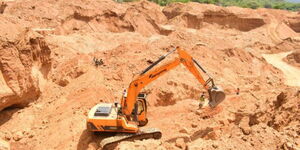The Kenya Meteorological Services on Wednesday, April 8th, issued an alert to Kenyans on forthcoming heavy rains within the next seven days, this comes in the wake of another alert that was issued on Monday, April 6th by Food And Agriculture Organization (FAO) representative to Kenya Tobias Takavarasha, warning Kenyans of a possibility of the second generation of desert locusts ravaging the nation and neighbouring East African countries.
The alerts may spell doom to the country if they are to pass as most people are already facig economic challenges in dealing with measures taken to fight and combat the spread of covid-19.
The second generation of locusts is expected to be 20 times bigger than the first army of locusts that invaded North Eastern, Eastern and some parts of Western Kenya.
https://www.kenyans.co.ke/news/51701-20x-bigger-swarm-new-locusts-hit-kenya-video
In yesterday's alert residents of Narok, Lamu, Taita Taveta, Kitui, Tharaka, Murang’a, Nyeri, Kirinyaga, Tana River, Garissa, Mombasa and Kwale Counties, have been warned to stay prepared for heavy rainfalls.
According to Kenya Meteorological Services, the specified counties will experience rainfalls of above 70milimeters with the counties of Nyamira, Bomet, Kisii, Kajiado, Nairobi, Machakos, Makueni, Meru, Kiambu, Embu and Kilifi experiencing moderate rains of between 20 and 70mm.
With Kenya being part of the countries affected by the covid-19 pandemic experts have advised citizens not to be worried about the spread of the virus during the rainy season, arguing that the temperatures will not be that low to support the spread of the virus.
Dr David Gikungu, the Deputy Director in charge of Climate at Kenya Meteorological Services, points out that even though there is usually a lot of rainfall in April the temperatures do not necessarily go very low.
“In April, the temperatures are not that low but will be lower compared to March and February because of the cloud cover as a result of rains''.
Temperatures of 15 degrees are expected over central Kenya, central Rift Valley and some parts of the Western region while residents of Nyeri, Meru, Nyandarua and Nakuru should stay prepared with warm clothing as the temperatures are expected to fall below eight degrees Celcius.
Dr Gikungu has however issued cautions to Kenyans stating that they should take extra caution as directed by the government.
Temperatures are expected to fall in May, June and July, with the humidity, experienced creating a good breeding ground for viruses causing colds, flus and other related respiratory illnesses.
Previously heavy rains have caused havoc within different parts of the country and the timely warning is expected to help Kenyans stay better prepared to avert destructions caused by rains.
County governments that have previously been blamed for unpreparedness when it comes to disasters are expected to clear up their drainage systems to mitigate flooding in towns and residential areas.












